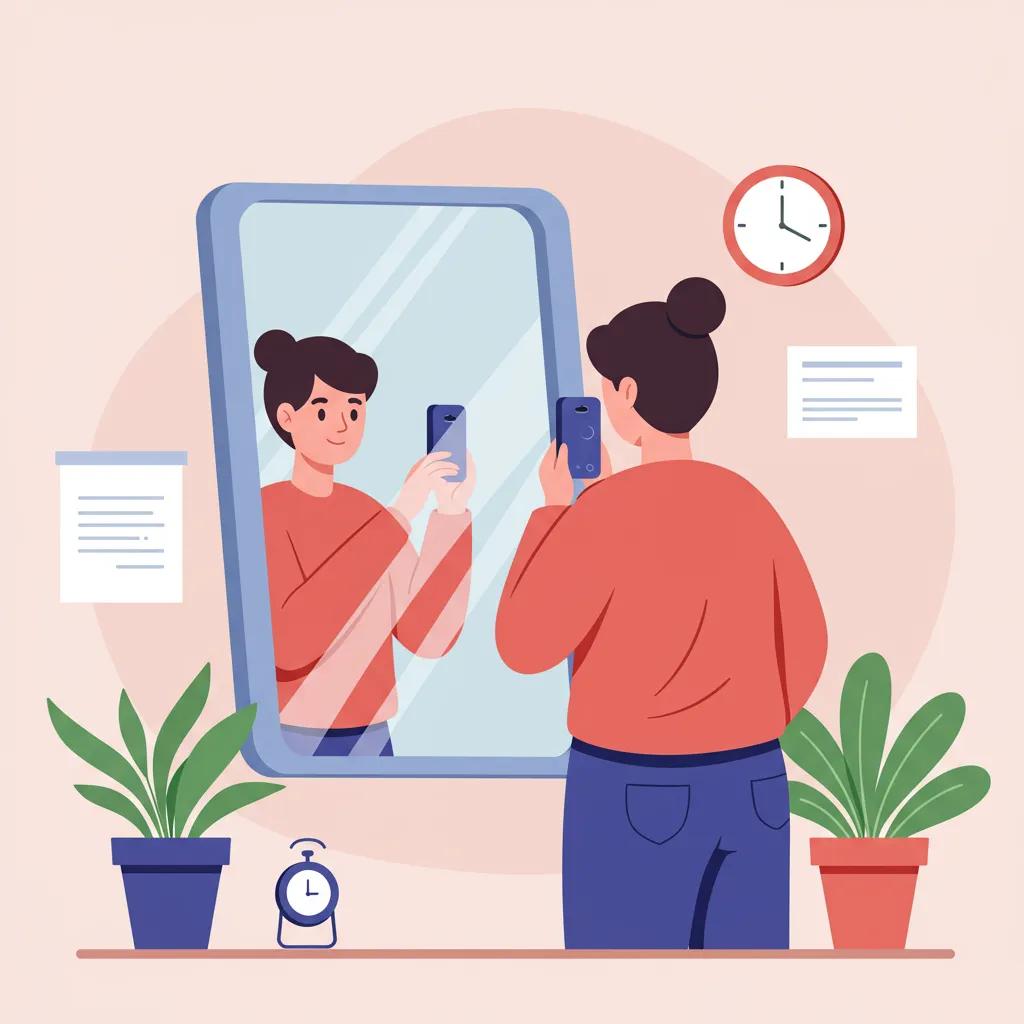Body Dysmorphic Disorder: Daily Habits That Reduce Checking and Manage BDD Urges
Body dysmorphic disorder (BDD) causes intense preoccupation with perceived appearance flaws and drives repetitive checking behaviors that can dominate daily life. This article explains why checking occurs, which specific behaviors maintain the cycle, and—most importantly—what practical daily habits reduce BDD checking using evidence-based mechanisms like stimulus control, habit replacement, and exposure and response prevention (ERP).
You will learn a step-by-step daily routine to stop body checking, low-trigger mindfulness and self-compassion practices, quick coping strategies for common triggers, and clear guidance on when to seek professional care. Each section maps habits to therapeutic mechanisms (CBT, ERP, DBT, mindfulness) and offers short, safe exercises you can practice at home or under clinician supervision. Read on for actionable numbered plans, habit comparison tables, and clinician-aligned tips to integrate into a recovery-oriented routine that reduces mirror checking, skin picking, and reassurance seeking.
What Are Common Checking Behaviors in Body Dysmorphic Disorder?
Body checking in BDD describes repetitive actions intended to reduce distress about appearance, but these behaviors paradoxically reinforce preoccupation through negative attentional bias and short-term relief. Checking behaviors function as compulsions: they temporarily lower anxiety (negative reinforcement) and increase focus on perceived flaws, which strengthens the checking cycle and prolongs distress. Understanding common checking behaviors helps target specific daily habits that interrupt reinforcement and build alternative responses that reduce urge intensity. Below is a concise list of the most frequent checking behaviors to recognize and track.
BDD checking behaviors include the following common actions:
- Mirror checking or prolonged mirror gazing that examines perceived flaws repeatedly throughout the day.
- Skin picking or grooming rituals aimed at “fixing” small imperfections.
- Reassurance seeking from others about appearance and requests for feedback.
- Excessive camouflaging or comparing appearance to photos and peers.
Identifying these behaviors creates a clear target for habit change and informs which daily strategies—like scheduled mirror time or ERP practice—are most relevant for interrupting the cycle and reducing checking.
How Does Mirror Checking Affect BDD Symptoms?
Mirror checking narrows attention to perceived flaws and magnifies visual details, which increases anxiety and fuels repetitive inspection. The mechanism is attentional bias: repeated mirror use trains the brain to scan for imperfections, reinforcing beliefs that something is wrong and prompting more checking. In the short term, looking in a mirror can reduce anxiety briefly, but in the long term it increases preoccupation, heightens avoidance or camouflaging, and strengthens distorted self-image. Recognizing that mirror checking is both a safety behavior and a maintenance factor helps explain why structured reductions—rather than abrupt avoidance—are more effective for lasting change.
Mirror-checking reduction is best approached with controlled, measurable steps that replace automatic checking with planned practices. This leads into specific habit strategies, such as scheduled mirror time, mindful distractions, and ERP-based exposure exercises designed to weaken the checking–relief link.
What Are Other Compulsive Checking Behaviors Like Skin Picking and Reassurance Seeking?
Skin picking and reassurance seeking operate similarly to mirror checking: both are compulsive responses to distressing appearance thoughts and both provide temporary relief that reinforces the compulsion. Skin picking often increases when hands are idle or when attention narrows to skin texture; it can produce physical harm and requires harm-minimization strategies. Reassurance seeking—asking others whether a perceived flaw is noticeable—reduces anxiety briefly but perpetuates dependence on external validation and prevents internal belief updating. Safe management includes habit-replacement techniques and stimulus control to reduce opportunities for picking and structured behavioral experiments to reduce reassurance dependence.
Addressing these behaviors starts with tracking frequency and triggers, then introducing alternative actions that satisfy sensory or social needs without reinforcing the compulsion. The next section presents concrete daily habits that translate these mechanisms into practice.
Which Daily Habits Help Reduce Mirror Checking and Body Checking in BDD?
Daily habit change relies on three components: stimulus control to limit triggers, scheduled practice to reduce compulsive frequency, and habit replacement to satisfy urges safely. Implementing a simple, stepwise routine—short planned checks, immediate alternative actions, and brief reflection—reduces reinforcement and retrains attention away from flaws. Below is a practical, numbered set of daily habits you can begin today to reduce mirror checking and body checking with clinician-aligned tips for safety and progression.
Follow these step-by-step daily habits to limit checking:
- Schedule brief mirror time: Perform one focused, 5-minute mirror check in the morning and one in the evening with a clear objective.
- Use a habit replacement: When an urge occurs, perform a 3-minute sensory grounding task (describe 3 objects, hold an ice cube, or press a textured object).
- Implement brief ERP tasks: Create a simple hierarchy and practice short exposures without engaging in checking responses.
- Track and review: Use a daily log to record urges, responses, and success; review weekly to adjust goals.
These daily steps prioritize gradual reduction over abrupt avoidance, which supports learning and reduces rebound anxiety.
Introductory explanation before the habit table: The table below compares core daily habits by mechanism and gives concrete examples you can use to build a practical routine and monitor progress.
| Habit | Mechanism | Daily Action / Example |
|---|---|---|
| Scheduled Mirror Time | Stimulus control and predictable exposure | 5-minute mirror checks at 9:00 AM and 8:00 PM with one focused observation goal |
| Mindful Distraction | Habit replacement and urge delay | 3-minute grounding (5-4-3-2-1) when urge hits |
| ERP Mini-Practice | Extinction of response through prevented compulsion | 2–5 minute exposure to a mildly triggering stimulus without checking |
| Trigger Mapping | Awareness and stimulus reduction | 10-minute daily trigger log with context and urge rating |
This comparison clarifies how each habit reduces checking and provides easy examples to implement today. The following H3s give more detail on scheduling mirror time and mindful distractions.
How Can Scheduled Mirror Time Limit Compulsive Checking?

Scheduled mirror time uses stimulus control to convert uncontrolled checking into predictable, limited exposures that reduce reinforcement and habituate distress. A practical protocol: set two daily 5-minute appointments as the only permitted mirror use for appearance inspection, define a single objective for each session (e.g., identify one neutral observation), and avoid analyzing or comparing during the check. For many people, this predictable structure reduces the urge frequency because the brain learns the check is available at specific times and no longer requires constant scanning.
If distress spikes during scheduled checks, scale duration down (two 2-minute checks) and pair with breathing to regulate anxiety. Clinician-guided variations, common in structured programs, add accountability and safely increase exposure over time.
What Mindful Distraction Techniques Can Redirect Checking Urges?
Mindful distraction interrupts the immediate compulsion by shifting attention through sensory-based grounding or short focused tasks that reduce urge intensity without avoidance. Effective options include the 5-4-3-2-1 grounding (name five things you see, four you feel, three you hear, two you smell, one you taste), box breathing for two minutes, or a quick tactile task like squeezing a stress ball while naming three non-appearance-related positives. These techniques operate by reorienting attention circuits and providing a low-trigger substitute behavior.
Practice each distraction proactively—use them when urges are mild, so they become automatic alternatives to checking. Combining mindful distraction with brief ERP work (delay checking by practicing a grounding task first) strengthens response prevention and supports habit replacement.
How Does Cognitive Behavioral Therapy Support Daily Habit Changes for BDD?
Cognitive Behavioral Therapy (CBT) provides the theoretical framework for habit change in BDD because it targets the thoughts, behaviors, and avoidance patterns that maintain checking. CBT and its behavioral arm, Exposure and Response Prevention (ERP), work by exposing a person to feared stimuli while preventing compensatory behaviors, thereby weakening the anxiety–compulsion link. Daily habit change uses CBT principles—cognitive restructuring, behavioral experiments, and graded exposure—to create measurable practice routines that change belief networks and reduce checking. Below is a table mapping therapeutic techniques to daily practice steps for clarity and immediate application.
| Therapeutic Technique | Core Component | How to Practice Daily |
|---|---|---|
| Cognitive Restructuring | Identify and challenge distorted beliefs | 5–10 minute thought record addressing one appearance thought daily |
| ERP (Exposure & Response Prevention) | Graded exposure with response prevention | Short, planned exposures (2–5 min) without checking, recorded in a hierarchy |
| Behavioral Experiments | Test predictions and gather evidence | One small experiment per week that tests a feared outcome (e.g., go out without camouflaging) |
| Behavioral Activation | Increase valued activity to reduce rumination | Schedule 20–30 minutes of rewarding activity daily to replace checking time |
Integration note on clinical programs: Evidence-based therapies like CBT and ERP form the clinical foundation for the daily habits described above. Specialized treatment programs teach these techniques through structured practice, therapist feedback, and repeated in-session exercises that accelerate skill acquisition. In settings that emphasize skill rehearsal, clinicians guide hierarchy construction, supervise ERP practice, and coach on cognitive restructuring so habits transfer safely to home routines.
What Is Exposure and Response Prevention and How Can It Be Practiced Daily?
Exposure and Response Prevention (ERP) reduces checking by repeatedly exposing individuals to triggers while preventing the checking response, which leads to natural anxiety decline and belief updating. A daily ERP micro-protocol: create a brief hierarchy (rank triggers 1–5), select a level-1 or level-2 trigger, expose yourself for 2–5 minutes without checking, record pre- and post-urge ratings, and repeat once or twice daily. Safety guidance: keep exposures short, avoid high-risk situations alone (e.g., severe self-harm risk), and consult a clinician for more intense exposures.
Consistent, small ERP practices produce measurable reductions in urge intensity and checking frequency and can be combined with scheduled mirror time and mindful distractions to scaffold response prevention.
How Does Cognitive Restructuring Help Manage Distorted Body Image Thoughts?
Cognitive restructuring identifies biased interpretations (e.g., “Everyone notices my flaw”) and replaces them with balanced evidence-based statements, reducing the driving power of appearance-related thoughts. A daily 5–10 minute thought record targets one automatic appearance thought: write the situation, rate belief strength, list evidence for and against, and generate a balanced alternative thought. Behavioral experiments test these alternatives—if the balanced thought predicts outcomes more accurately over time, checking decreases because beliefs no longer demand verification.
Using brief cognitive techniques daily creates progressive mismatch experiences between predicted catastrophes and actual outcomes, which weakens checking rituals and supports long-term recovery.
What Role Does Mindfulness and Self-Compassion Play in Managing BDD Checking?
Mindfulness and self-compassion lower the intensity and frequency of checking urges by changing the way attention and self-evaluation operate. Mindfulness reduces rumination and reactivity by training nonjudgmental awareness of thoughts and sensations, while self-compassion reduces shame and harsh self-criticism that often trigger checking. Together, these approaches decrease urge-driven behavior and create emotional space for deliberate habit practice. The next paragraphs list targeted mindfulness exercises and micro self-compassion practices suitable for daily use.
Brief mindfulness exercises that are low-trigger and practical:
- Mindful breathing (2–3 minutes): Focus on breath sensations and label distraction without analyzing appearance.
- Adapted body scan (3–5 minutes): Focus on neutral sensations (hands, feet) and avoid evaluative scanning of perceived flaws.
- Grounding via senses (2 minutes): Name sensory details in the environment to reduce inward focus.
Which Mindfulness Exercises Reduce Body Image Anxiety?

Low-trigger mindfulness exercises reduce body image anxiety by shifting attention away from evaluative scanning and into present-moment sensory experience. Practical options include two-minute mindful breathing, a brief hands-and-feet body scan that avoids appearance-focused areas, and a contextual grounding exercise naming sensory inputs. Practice frequency: 2–3 short sessions daily or one 10-minute session plus micro-practices during urge moments. These exercises decrease the automatic focus on perceived flaws and lower urge intensity, which supports engagement in ERP and scheduled mirror time.
Consistent mindfulness practice builds tolerance for discomfort and creates cognitive space for using CBT techniques, leading naturally into self-compassion practices that target shame.
How Can Self-Compassion Practices Decrease Urges to Check?
Self-compassion reduces checking by replacing harsh self-criticism with kindness, which diminishes the emotional urgency behind compulsive behaviors. Micro-practices include a 60-second self-compassion break (acknowledge distress, remind yourself that suffering is shared, offer kind words) and a brief compassionate letter prompt addressing one appearance-related fear. These exercises interrupt the shame-checking loop and provide an internal soothing response, reducing reliance on checking for relief.
Integrating self-compassion into daily habit plans—after a scheduled mirror check or before an ERP practice—improves emotional regulation and increases the chance that new habits will stick.
How Can You Identify and Cope With BDD Triggers to Prevent Checking?
Identifying triggers is foundational to preventing checking because awareness enables targeted stimulus control and anticipatory coping. Common triggers include social situations, photographs, perceived scrutiny, and unstructured mirror time; tracking these through a trigger log reveals patterns that guide habit planning. Coping mechanisms range from immediate urge responses (grounding, distraction) to planned strategies (ERP, behavioral activation) and environmental changes (reducing mirror visibility). The list below provides quick methods for identifying triggers and practical coping options to incorporate into your daily routine.
Ways to identify triggers and initial coping actions:
- Keep a short trigger log: Note context, intensity, and response after each urge.
- Ask structured questions: What preceded the urge? Where was I? Who was present?
- Use brief coping scripts: Prepare one-sentence reminders for urge moments (e.g., “This is an urge, not a fact”).
Tracking triggers enables targeted habit adjustments and incremental exposure planning in the next steps.
What Are Common Personal Triggers for BDD Checking Behaviors?
Personal triggers for BDD checking typically include social interactions, seeing photos or reflections, feeling self-conscious, and idle or lonely moments when attention shifts inward. A practical identification method involves a brief daily log: note the situation, rate the urge (0–10), and record the immediate behavior. Prompting questions—Was I alone? Was I tired? Did I see a photo?—help pinpoint repeat contexts. Once identified, triggers can be addressed with environmental changes (covering mirrors, limiting phone photo viewing), scheduled exposures, and coping procedures.
Systematic identification supports targeted ERP and habit-replacement work, which reduces checking frequency over time.
What Healthy Coping Mechanisms Support Long-Term BDD Recovery?
Sustainable coping mechanisms combine behavioral, cognitive, and social strategies that reduce relapse risk and strengthen resilience. Key approaches include regular ERP practice, cognitive restructuring routines, mindfulness and self-compassion micro-practices, structured behavioral activation to reduce idle checking time, and consistent social support or accountability. Implement these within a daily schedule: brief ERP tasks, a 5–10 minute thought record, one mindfulness session, and an evening review of progress. Monitoring and adjusting strategies weekly keeps recovery incremental and sustainable.
Prioritizing several complementary strategies ensures that when one approach is less effective, others provide backup—this redundancy strengthens long-term habit change and decreases checking relapse.
When Should You Seek Professional Help for Severe BDD Checking Behaviors?
Professional care is recommended when checking behaviors cause significant functional impairment, safety risk, severe distress, or fail to improve with structured self-help. Key red flags include inability to work or attend school due to checking, skin damage from picking, suicidal ideation, or persistent escalation despite self-directed interventions. Treatment options span outpatient CBT with ERP, intensive outpatient programs, and residential care for severe or treatment-resistant cases. The checklist below helps determine when to escalate care and which level of support may be most appropriate.
Checklist: When to seek professional help
- Functional impairment: Checking interferes with work, relationships, or daily responsibilities.
- Safety concerns: Skin damage, medical complications, or worsening mental-health symptoms.
- Treatment resistance: No improvement after consistent self-help and outpatient therapy.
If any of these apply, discussing options with a mental health clinician is warranted to design a tailored care plan.
How Does Residential Treatment Support Daily Habit Formation for BDD?
Residential treatment supports habit formation by embedding daily routines into structured schedules, offering clinician-guided ERP practice, and providing consistent feedback and monitoring. In residential settings, individuals complete repeated, supervised exposures, practice cognitive restructuring with therapists, and rehearse mindfulness and self-compassion exercises in a safe environment. The operational features—individualized treatment plans, intensive therapy sessions, and an intimate therapy environment—help consolidate new habits faster than intermittent outpatient sessions. For people who struggle with severe or treatment-resistant checking, residential care can provide the concentrated practice and accountability needed to change entrenched compulsions.
Specialized residential programs reinforce habit formation through daily coached exercises and peer-supported routines, accelerating the translation of therapeutic skills into everyday life.
What Are the Benefits of 24/7 Professional Support in Managing BDD?
Round-the-clock professional support helps stabilize routines, provide immediate crisis intervention, and reinforce new habits precisely when urges peak. Continuous availability allows clinicians to coach through exposures in real time, redirect unsafe or escalating behaviors, and adjust interventions rapidly based on observed responses. Examples where 24/7 support reduces risk include managing severe skin picking during acute urge spikes or helping a resident tolerate an intense exposure without resorting to checking. Ongoing support also aids discharge planning and transition to outpatient care by ensuring habits are robust before return to unstructured settings.
Access to continuous clinical support shortens the time needed to generalize skills, reduces relapse risk, and ensures safety for individuals with severe checking behaviors.
Integration on 24/7 support: Residential care often includes 24/7 clinician availability, which enables immediate support during high-urge moments and consistent reinforcement of response-prevention strategies.





